
DURING THE 2018 DANSATHON EDITION, 15 PROTOTYPES MIXING DANCE & TECHNOLOGY WERE CREATED
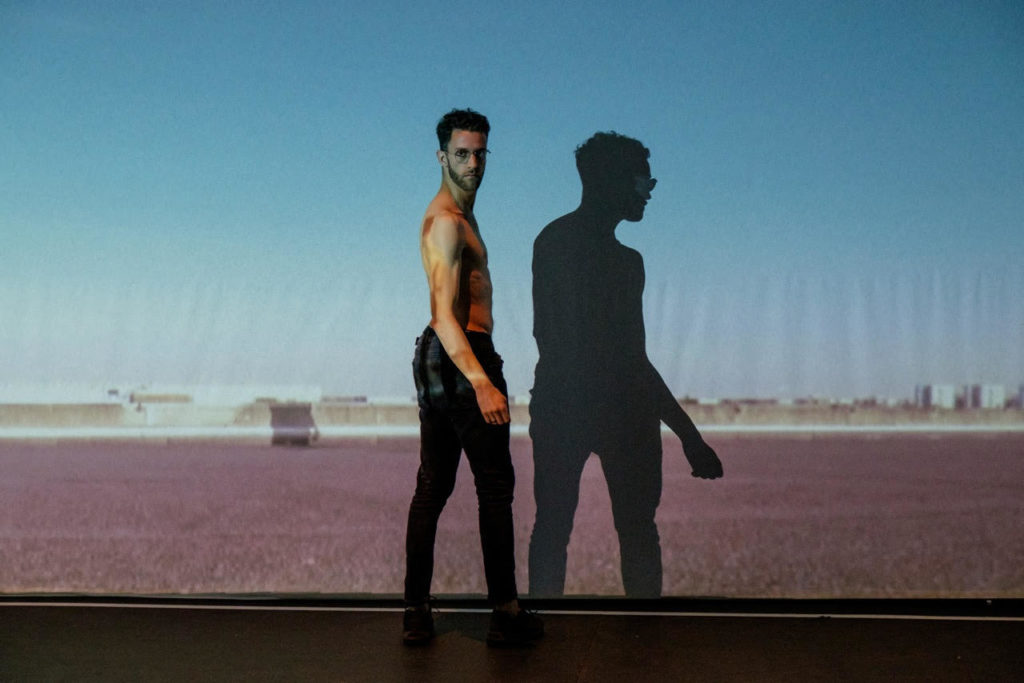
DANS(E) SA PEAU
Emotion of places, emotion of links. You enter a theatre and find an empty stage.
Lyon 2018
DANS(E) SA PEAU
Emotion of places, emotion of links. You enter a theatre and find an empty stage.

The project
You enter a theatre and find an empty stage: now it’s your turn to get up under the lights. You’re on stage instead of the dancer, who’s waiting elsewhere. You can see this elsewhere all around you: the 360° projection takes you there. The dancer has chosen this elsewhere, because it speaks to his inner self: it’s a vacant place, perhaps abandoned, perhaps empty, but a place full of meaning for him, which he’s waiting to share with you.
Both the dancer and you are wearing sensors that collect your body data – heartbeat, breathing. You slowly start to understand that this data affects each other’s visual and sound environments. Now you’re ready to start the dialogue, to compose with each other, for each other.
Team’s intentions
« We collect personal data using connected objects to create an imminently carnal meeting space between dancer and spectator. This scientific data is transformed into poetic, sound or visual signals, and fuels the encounter between dancer and spectator. By immersing themselves in the sensations and corporality of the other, both will emerge from this experience marked with a tangible trace. »
Technical specifications:
Situation: From IOT to IOE, towards an internet of emotions
Playground: A vacant space
Conception : Michael Cros (Choreographer), Bouside Ait-Atmane (Dancer), Anouk Audart (Technician/Maker), Fano Ramparany (Developer), Carole Raphanel (Communicator), Chloé Riffault (Designer).
Interpretation: Bouside Ait-Atmane
Technologies: 360 video recording+ mapping for diffusion on walls. Pulse sensors (arduino) and transformation into a visual / sound signal (Using python language for sending on Châtaigne software).
Real-time sound recording.

Image Description VIBES (LAUREATE 2018)
A trans-vibes all over the world. Vibes is an application that uses choreography and sound to bring people together.
Lyon 2018
Image Description VIBES (LAUREATE 2018)
A trans-vibes all over the world. Vibes is an application that uses choreography and sound to bring people together.

The project
Vibes is an application that uses choreography and sound to bring people together. It empowers users to get together and share a dance moment (a bit like a flash mob) in a given venue, like a park, or in different cities or countries, at the same time. Equipped with a Bluetooth speaker or earphones, the dancers improvise their dance together based on audio-guidance by a choreographer. The application also allows them to co-create music according to their gestures and spatial movements.
Team’s intentions
« The objective is to make dance accessible to everyone, and to bring people together. We want to give to people who are physically distant or alone the possibility to connect so they can experience dancing together on co-created music, while breaking down barriers through technology. People can now experience bodies moving in harmony for a fleeting moment, no matter where they are. We also want to create a sense of belonging despite the distances involved. »
Technical specifications:
Situation: Dance beyond dimensions
Playground: An internet-connected space
Conception : Eric Minh Cuong Castaing (Choreographer), Maëlle Déral (Dancer), Anaïs Nisimov (Technician/Maker), Xavier Boissarie (Developer), Romain Constant (Sound Designer), Anaïs Tardivon (Communicator).
Music: Sounds taken by Anaïs Nisimov with voice records of Eric Minh Cuong Castaing.
Technologies: smartphone, headphones, video projector, loudspeaker, sound card, microphone, recorder, Ableton Live 10 et Max4live, Illustrator, laser cutter, Nodal.studioConception.

CLOUD DANCING (LAUREATE 2018)
How to escape everyday life and space by sharing an experience together?
Liège 2018
CLOUD DANCING (LAUREATE 2018)
How to escape everyday life and space by sharing an experience together?

The project
Cloud Dancing is an immersive, interactive dance show that combines dance with virtual reality. Spectators can experience choreography performed by dancers and 3D images of dancers in a theatre, but also in public venues like cafés, with friends, or at home on their favorite couch.
Spectators can interact with the dancers live or via their smartphones, or through virtual reality headsets to shape the choreography in real time. Cloud Dancing can extend beyond borders, is available at any time, and can thereby bridge the gap between the theatrical and daily spaces. The possibilities are endless because Cloud Dancing brings physical and digital realities together.
Team’s intentions
« Dance and music are used to tell stories, express emotion, convey experiences. They are universal in, and intrinsic to, communication. So why not use dance in your everyday life?
People can have an unrelenting, hectic, life-rhythm, and sometimes it’s hard to escape. We are inspired by the need for escapism from this busy rhythm, and see dance and creativity as the solution. Our purpose was to develop specific areas for the audience to access dance, and escape their routine. We invite people to experience dance in an environment that’s comfortable and let them take what they need from the experience; fulfilling their needs by immersing them in an environment that stimulates their senses. »
Technical specifications:
Situation: Unrhythm
Playground : Everyday space.
Conception : Sophie Caron (Facilitator), Julia Houdin (Dancer), Emily Kirwan (Designer), Guida Mauricio (Choreographer), Aurélien Merceron (Developer), Roman Miletitch (Technician/Maker), JY (Sound designer).
Music: Sound composition by JY and Guida Mauricio based on ‘The Bane of Tadziu’by Norman Dauskardt
Technologies: Vvvv Multipurpose toolkit realtime nodal programming, Leap Motion, Kinect 2, Dx11 PointCloud, Photogrammetry, Cardboard VR Headset + smartphone, WebVR (A-frame, Three. js, javascript, nodejs), Reaper.
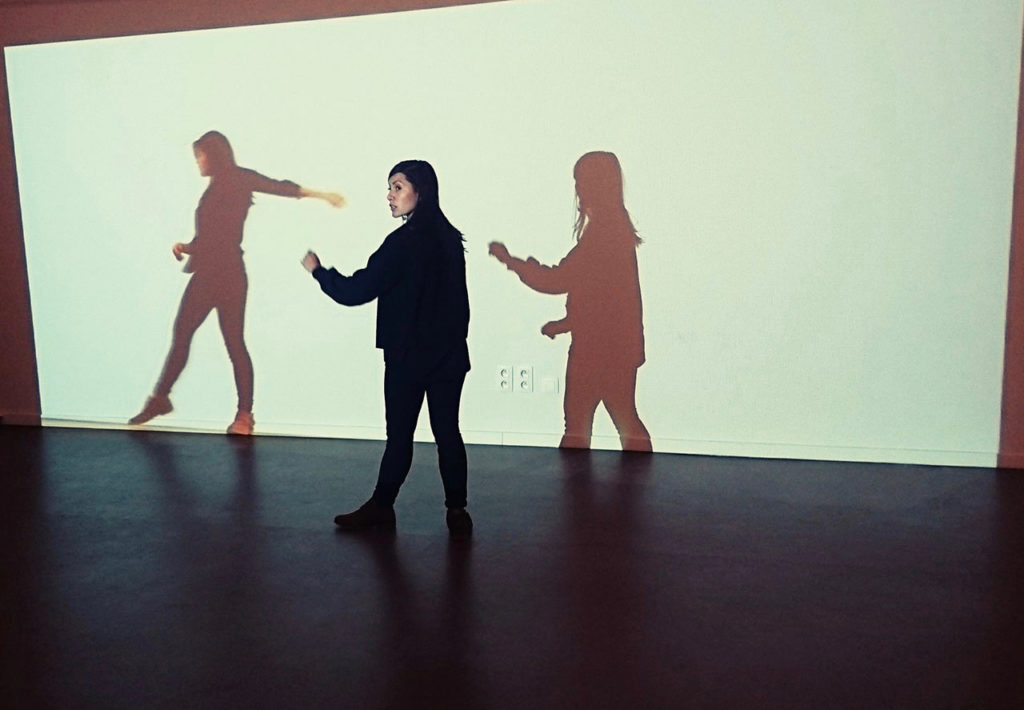
DANC@TIME
In a bustling city venue thronged with pedestrians (a station, a gallery, arcades, etc.), a passer-by is called out: "How fast are you living?”.
Liège 2018
DANC@TIME
In a bustling city venue thronged with pedestrians (a station, a gallery, arcades, etc.), a passer-by is called out: "How fast are you living?”.

The project
In a bustling city venue thronged with pedestrians (a station, a gallery, arcades, etc.), a passer-by is called out: “How fast are you living?”. The person’s projected image walks, moves backwards, multiplies and creates movement. This movement gradually changes into a dance based on a well-known choreography: a ballet, a contemporary piece, a break dance, etc… and voila, the passer-by has begun to dance! The person can regain control of her image and make it mimic her movements or let the program continue animating it on the basis of “a step, a gesture, a unique dance”; a dialogue is created between the person and her image with the sublimated movement as a means of communication. Persons with reduced mobility can also experience Danc@time.
Team’s intentions
« We are living faster and faster, sometimes locked in our work routine. Is there a place for inner self and contemplation of the beauty of life in all this?
With Danc@time, we would like to amazingly surprise people by bringing fun and breathing into their daily life. Our purpose is to propose people a break and a real connection to their body and feelings, as a gateway to emotions. Entering the experience, living it, feeling it, one may wonder how fast life is flying. Thanks to new technologies, we transform daily life movements/gestures into poetry. »
Technical specifications:
Situation:
Playground:
Conception : Jordi L Vidal (Choreographer), Manu Di Martino (Choreographer), Ely Morcillo (Dancer), Deborah Bouvy (Designer), Laurence Moletta (Designer), Benjamien Lycke (Technician), Audrey Law-Thime (Facilitator).
Interpretation: Manu Di Martino, Audrey Law-Thime, Ely Morcillo.
Music: Benjamien Lycke – Laurence Moletta
Technologies: From a technical point of view, we were inspired by UC Berkeley’s research on the «Everybody dances now » automatic learning technology.
Sampler 3 – Tom Butterworth, Everybody Dance Now – Caroline Chan, Shiry Ginosar, Tinghui Zhou, Alexei A. Efros (UC Berkeley), Microsoft Kinect, VicoVR , Stereolabs ZED, Orbbec, OpenPose, Interactive video creation – Manu Di Martino.
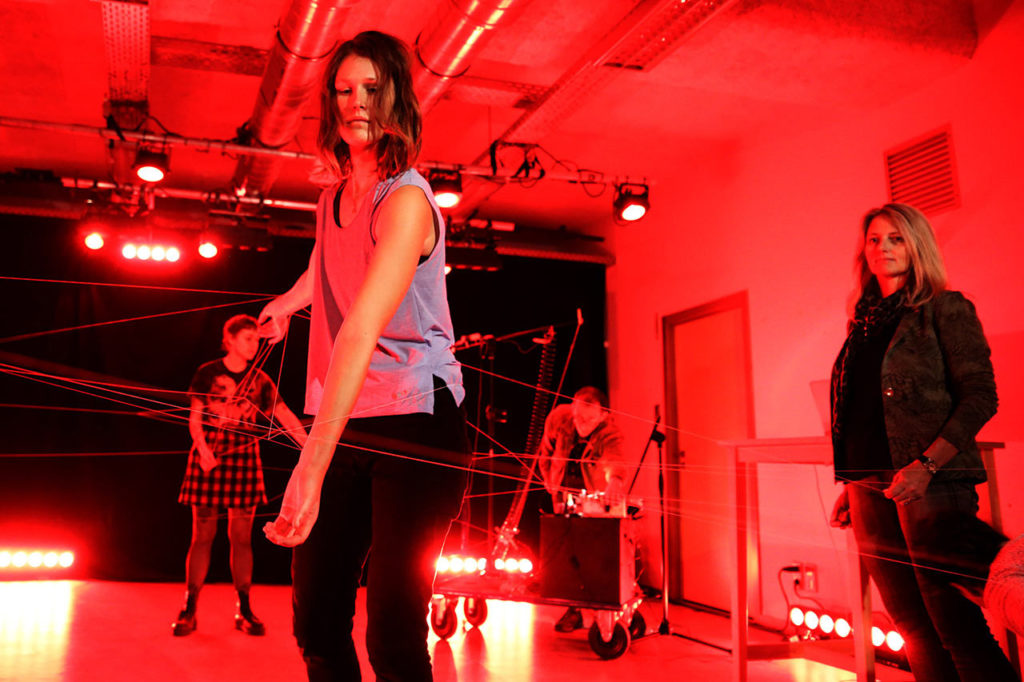
SIGNAL
Amplify the inner feeling of dance and make it visible to weave links with others.
Liège 2018
SIGNAL
Amplify the inner feeling of dance and make it visible to weave links with others.

The project
Multiple incentives – light, sound, vibration, temperature changes – are used to surprise the spectators. They react with micro-movements, which are detected and reinterpreted by a performer who sends them back, through movement, via a sensory digital feed to other receivers-spectators. This feedback loop is conducive to play and makes one question one’s own behaviour.
Feelers are put out like threads for weaving a new societal web. Complicity gradually develops between strangers sharing the experience. Technology-assisted, the linkage goes viral as it rises into the cloud, multiplying connections between performers in remote places, cities and countries. The ephemeral nature of this collaborative performance leaves its wake behind it as it propagates through the desire of other citizens to experience the performance whenever it comes to town.
Team’s intentions
« PCs, smartphones, connected watches, social networks… Our daily lives definitely seem to rest on economy of self.We seek shelter in the monotony of daily gestures and habits while neglecting our physical links with others. Dancing can provide us with unique ways of experiencing the body and the emotions.
Using technologies we all love, we offer the public an opportunity to reclaim their physical mobility by inviting them to an interactive event in a variety of locations. Both on and off the traditional stage, or through collaborative intervention, everyone can become an actor and experience out-of-the-ordinary motion while forging a link with others.”
Technical specifications:
Situation: From IOT to IOE, towards an internet of emotions.
Playground : A vacant space.
Conception : Caroline Poisson (Technician/Maker), Jean-Marc Matos (Choreographer), Nick Burge (Sound creator, Developer), Justine Copette (Dancer/mediator), Céline Mothais (Designer), Colette Bawin (Facilitator).
Interpretation : Justine Copette (Danseuse performeuse/ médiatrice)
Technologies : Sensors, wifi, open source software, sound processing, interactives lights.

YOU SKY
An unexpected interaction with light in the public space: the choreography of a visitor
Liège 2018
YOU SKY
An unexpected interaction with light in the public space: the choreography of a visitor

|
The project A sky that evolves in reaction to the moves of people passing by in an urban space. Suspended in the public space, You Sky is an installation that responds to the trajectories of the people on the ground. By using the movement and the light You Sky underlines the poetry of the movements and common motion in urban life. Thanks to new technologies, You Sky attempts to engage the inhabitants of urban spaces into the creation of unexpected performances for the public space. The public is at the same time audience and creator, depending on the place where he is in the public space. The technology deletes frontiers between daily space and choreographed space, between dancer and spectator. Team’s intentions “Our purpose is to make passers-by stop, to invite them to play with the space and change their daily routine (for instance by changing their itinerary to pass under the installation on their way to somewhere, to play with it if they have a few minutes, etc). Among possible developments, You Sky can be in different cities at the same time. At the end of the day, the installation shows back the trajectories of the day for its own location, but also for the other cities.” Technical specifications: Situation: Playground: Conception: Delil Lizati (Designer), Juliet Moyersoen (Technician/Maker), Giorgos Sioras Deligiannis (Choreographer), Virginie Honvoh (Dancer), Marie Baurins (Facilitator), Bram Lattré (Developer) Interpretation: Virginie Honvoh Technologies: 3D render, Kinect, programming, lightning, laser cutting. |

DIGITAL UMBILICAL (LAUREATE 2018)
How can technology be soulful? An experience which allows for an organic connection between strangers, deepened through the use of technology.
London 2018
DIGITAL UMBILICAL (LAUREATE 2018)
How can technology be soulful? An experience which allows for an organic connection between strangers, deepened through the use of technology.

|
The project In a one to one experience, wearable technology worn by both audience member and performer is used to create a soundscape from the breath of the dancer and the pulse of the spectator. Empathy grows between the dancer and the audience as they connect with the physiological experience of another. Digital Umbilical is unique to the moment and the individuals – a conversation between them, enhanced by the use of technology and the senses. The ability to experience the physicality and emotional state of another human is a way of positioning the human at the heart of this technological experimentation. Team’s intention « We got inspired by intimacy – what sparks it and how technology can add to a potential human connection. Intimacy is a shared experience and a choice to engage with each other. We kept returning to experience through the senses and the subtleness of an organically grown connection. We got inspired by the environment of the womb – universal, insular yet deeply intimate, a place of creation and growth. The environment will use learning algorithms to analyze data and patterns to respond to its inhabitants. » Technical specifications Situation: Dance beyond dimensions Playground : Bridge Conception : Lara Buffard (Facilitator), Renaud Wiser (Choreographer), Adam Seid Tahir (Dancer), Katelyn Notman (Communicator), Salomé Bazin (Designer), Jon Rowe (Technician/Maker), Simon Haenggi (Developer). Interpretation: Adam Seid Tahir Technologies: ECG, EMG, Proximity Sensor, BioFeedback, Wearables, Neural Networks. |
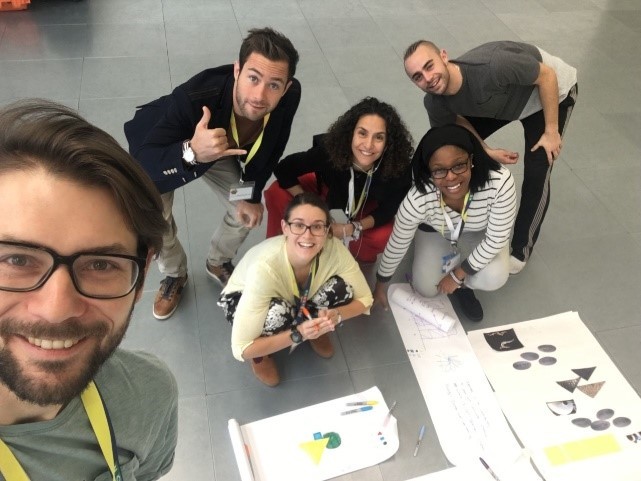
DANCING DATA
Dance is a vocabulary to express what is unspoken and unseen. Dancing can transform the perception of one’s body.
London 2018
DANCING DATA
Dance is a vocabulary to express what is unspoken and unseen. Dancing can transform the perception of one’s body.

|
The project Dancing Data co-creates a playful immersive experience together with the audience. Entering the playground they are invited to answer the question “What is your body?” Right from the start there is an entanglement between drawing out data, physical play through encountering the environment, and shifting awareness of the body and its meaning. Within the data playground, audience explores the senses and reactivates the awareness of their relationship with themselves. Through their physical interactions and ideas about bodies they contribute data which is transformed into a dance performance. Team’s intention « Dancing Data is an invitation to people to transform their perception of their body through data and dance. We have been exploring the potential of the human body as a data creator and interpreter. Using different sensing technologies, such as haptic feedback, sonic interaction, and data visualization we engage people with their bodies sensorially, emotionally and physically. This is the start of unlocking how data can become dance and how dance can become data. » Technical specifications Situation: Data Dance Playground: Blank space. Conception : Joumana Mourad (Facilitator), Gemma Peramiquel (Choreographer), Dan Baines (Dancer), Franz Danyash (Communicator), Neo Bokang Joy Moeti (Designer), Ivan Isakov (Technician/Maker). |
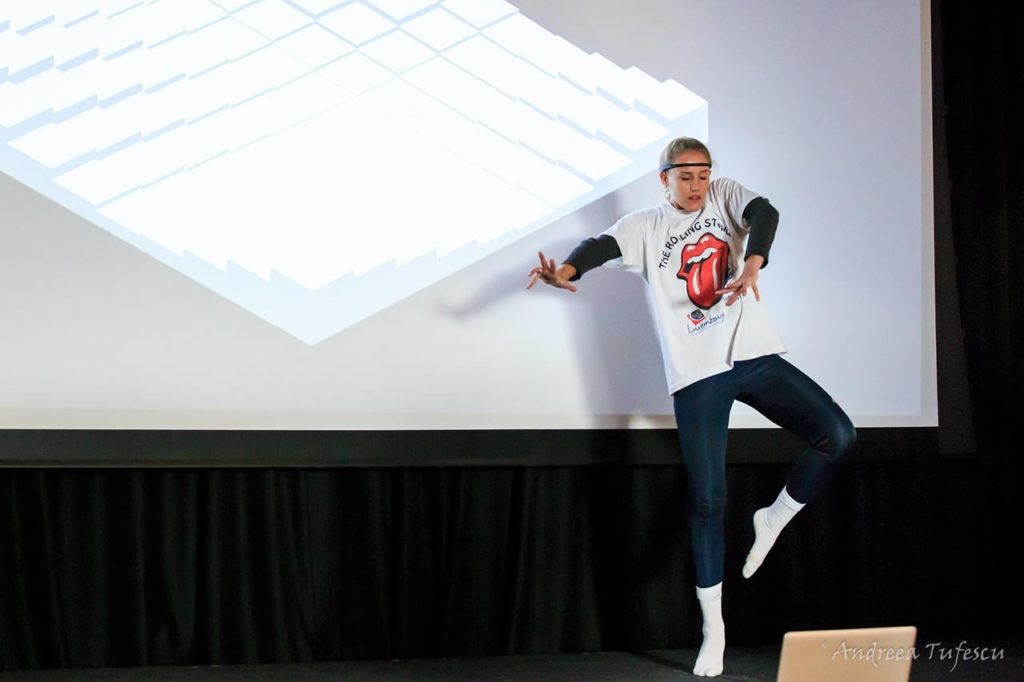
DEPENDANCE
Seeing the Unseen. Through visualising our internal states, DepenDance offers wearers a safe space beyond their emotions.
London 2018
DEPENDANCE
Seeing the Unseen. Through visualising our internal states, DepenDance offers wearers a safe space beyond their emotions.

The project
Through visualising our internal states, DepenDance offers wearers a safe space beyond their emotions, and equalises situations of dependency to progress beyond the static hierarchy of caretaking and support. Body metrics and projection are used to portray states of tension, stress and animation, and to show how these states change according to different stimuli including movement and interacting with others. DepenDance aims to move beyond the need for visual and verbal communication in care settings and to help increase the impact of dance in care and therapeutic contexts.
Team’s intention
« We were excited about the practical applications of how technology can support people in marginalized and excluded conditions, in enabling us to express what can’t be expressed.
We wanted to show that some vulnerability can’t be seen easily, and we want to make the unseen seen: we wanted to visualize & materialize the inner state externally to offer people increased self-awareness, and to work with their vulnerabilities and move to a state of empowerment and breaking dependent habits. »
Playground: School.
Conception : Sarah Levinsky (Facilitator), Junyi Hou (Choreographer), Murielle Werthauer (Dancer), Chantal Guevara (Communicator), Shama Rahman (Designer), Stephane Garti (Technician/Maker), Julian Tapales (Developer).

MOVE YOUR DAY
An app that transforms our daily routine into a story, promoting empathetic communication and increasing wellbeing
London 2018
MOVE YOUR DAY
An app that transforms our daily routine into a story, promoting empathetic communication and increasing wellbeing

The project
Most of us aren’t aware of the story we’re telling in our movements every day. What if we could find a way to express our daily movement as a story? Learn from it? Share it with others? Experience other people’s days? Appreciating our daily routine using the universal language of dance, sound and touch allows us to self-reflect and better empathise with the daily experiences of others.
Existing technology (heart monitors, accelerometers, geotagging, EMG) can be used to track daily movement and transform it into art through dance, animation, music and touch. As wearables advance in the data they collect, the data interpreted by Move Your Day will be able to generate more intelligent, artistic stories.
Team’s intention
« Viewing our day as a story acts as a point of self-reflection and an opportunity for us to empathise with others through a universal language. Sharing our story unlocks the potential of co-creation, with others responding with their own content. Dancers can be inspired to create, communicate and develop content. »
Playground: Everyday space
Conception : Cecile Bellaches (Facilitator), Kwame Asafo-Adjei (Choreographer), Claudia Syndergaard (Dancer), Dominique Ashby (Communicator), Pallavi Davé (Designer), Pascal Romme (Technician/Maker), Chris Bishop (Developer).
Interpretation : Cecile Bellaches, Kwame Asafo-Adjei, Claudia Syndergaard.
Technologies: Myo (EMG), camera for video and bespoke algorithm to create abstract movement animations.
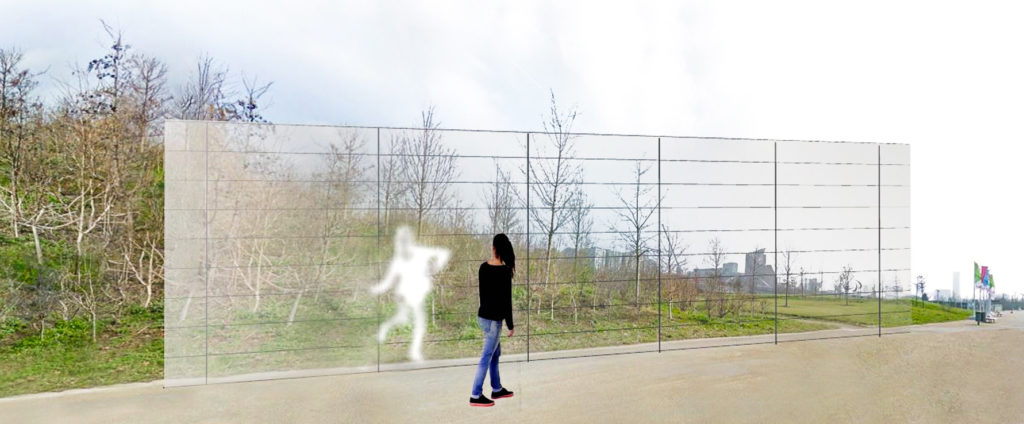
DOUBLE YOU
A daily reminder of our absolute freedom to move. Double You is a playful intervention to inject dance and creativity into everyday life.
London 2018
DOUBLE YOU
A daily reminder of our absolute freedom to move. Double You is a playful intervention to inject dance and creativity into everyday life.

The project
Double You is a playful intervention to inject dance and creativity into everyday life.
It is an interactive installation which reveals your shadow-like dancing double. People connect with themselves and their environment through a playful moment of dance, experience freedom and share this experience with other people.
Team’s intention
« Our goal is to make the audience feel the freedom in their body through dance in everyday life, so they connect with themselves, the others and the environment.
The shadows of the infrastructure cutting into the park were our main inspiration.
Playing with words, ideas, and movements, walking the park, testing, was our creation process. »
Playground: Olympic Park.
Conception : Stephanie Clarke (Facilitator), Amy Cartwright (Choreographer), Evangelia Koryla (Dancer), Christophe Guerard (Communicator), Samon Presland (Designer), Eda Sarman (Technician/Maker).
Interpretation: Evangelia Koryla
Technologies: LED Mesh screen, motion tracking, machine-learning: creating a database of movement using many performers, with wheelchairs, sticks, cyclists, suitcases, etc., which will continue to grow. Facial/body recognition: match the passer-by’s own body shape.

O
In-between disconnection and performance, “O” imagines a preposterous story about spectators kidnapped in a bubble outside time.
Liège 2018
O
In-between disconnection and performance, “O” imagines a preposterous story about spectators kidnapped in a bubble outside time.

The project
In-between disconnection and performance, “O” imagines a preposterous story about spectators kidnapped in a bubble outside time. The bubble, as organic and other-worldly as the inside of a womb, does not burst. The low-key technology recalls natural phenomena, such as flowing lava or cosmic nebula.
Conception: Barthélémy Antoine-Loeff, Julien Blomme, Aude Dupont, Pietro Marullo, Keita Joseph, Catherine Liégeois.
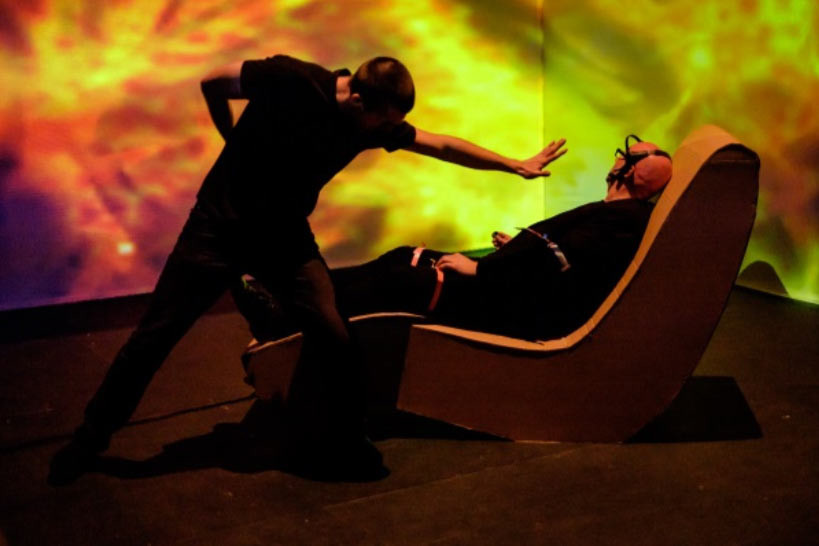
DANSORIEL
A decompression capsule to reconnect with others and ourselves.
Lyon 2018
DANSORIEL
A decompression capsule to reconnect with others and ourselves.

The project
DANSORIEL opens up the possibility of creating a DANCER-PRACTITIONER/SPECTATOR-PATIENT protocol by combining dance and technology.
1) Patients release their emotions. Sensors allow sounds and pictures to project their feelings: a diagnosis the dancer-practitioner can see.
2) The practitioner processes the data and takes inspiration from it to create the dance. He is also connected by technology. Each movement creates a sound in the capsule.
3) The practitioner gives the patient a new sensation: the dancer’s movements generate a slight vibration on the patient.
4) At the end of the therapy, the practitioner physically connects to the patient to end this momentary pause, bringing the patient back to the present moment and preparing him to return to everyday life.
Team’s intentions
« We’d like the audience to feel a sense of letting go that lets them take a break from everyday life. We want to raise awareness of how important it is to take time out for oneself and provide a glimpse of dance connected to new technology as a future therapy of our emotions.”
“DANSORIEL could also be tested at different places of everyday life (train stations, workplaces, shopping centres) and on several people to collect a database that would be used to write a show. »
Technical specifications:
Situation: Unrhythm
Playground : An everyday space
Conception : Fabien Prioville (Choreographer), Xavier Gresse (Dancer), Lucie Plançon (Designer), Théo Cardoso (Technician/Maker), Cyril Raymond (Developer), Rémi Borron (Communicator).
Interpretation: Xavier Gresse (Dancer)
Technologies: ECG, EMG, Proximity Sensor, BioFeedback, Wearables, Neural Networks.
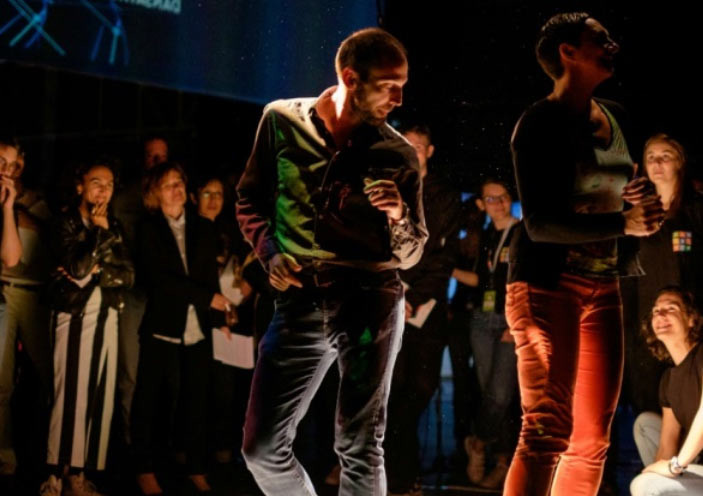
CROSS FLOW
Come and exit from your routine! Crossflow creates the possibility of an unexpected dancing encounter through everyday gestures and journeys.
Lyon 2018
CROSS FLOW
Come and exit from your routine! Crossflow creates the possibility of an unexpected dancing encounter through everyday gestures and journeys.

The project
Crossflow creates the possibility of an unexpected dancing encounter through everyday gestures and journeys. The experience unfolds in a public place people move through, in this case a train station. Sound shower speakers, digital pathways, lights and other technical devices are activated by passers-by when they walk around, surprising then enticing them in a playful way to move their body and meet other people for a danced moment.
Team’s intentions
« We were inspired by people passing each other in a train station without exchanging glances or even a word. What experience could create connections between rushing and waiting travellers through dance?
The goal is to adapt the project to other places people move through, offer the experience to more users at once and create more digital scenarios, choreography and music to reach all generations. »
Technical specifications:
Situation: Daily Routines
Playground: train/metro/airport (mobility)
Conception: Abdou N’gom (Choreographer), Morgane Lenzi (Dancer), Nicolas Giemza (Designer), Niels Demerlé (Technician/Maker), Emmanuel Roux (Developer), Eloïse Mini (Communicator).
Music: Mickael Jackson – Don’t stop till you get enough; Aretha Franklin – Think; Bruno Mars – Uptown Funk; Lou Bega – Mambo N°5.
Technologies: Augmenta.
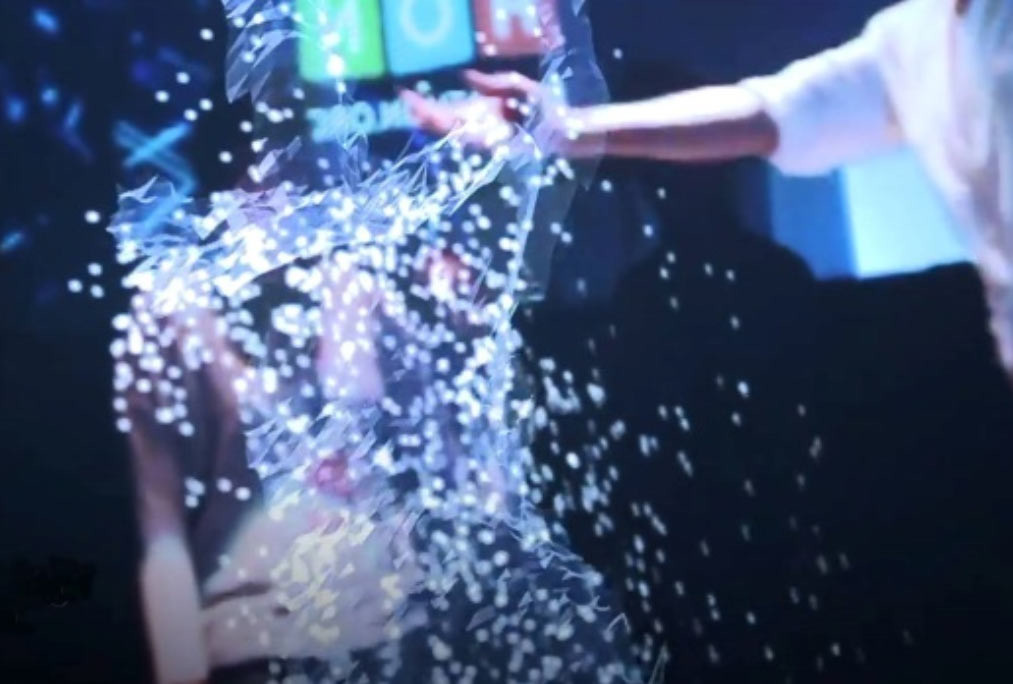
THE LAST DANCE
Reality augmented by a dance that stretches into infinity
Lyon 2018
THE LAST DANCE
Reality augmented by a dance that stretches into infinity

The project
What if the last dance was a dance that never ends, a dance we can’t see, a dance which appears as we receive an invitation?
The invitation to the last dance is a gift in exchange for a gift. Guests can invite other guests in turn. Sand and pagan music accompany the spectators, whose active presence has the impact of a digital double on the dance: the transformation of their choreography is the trace.
Team’s intentions
« We started out with the idea of a dance that could never end: the idea of exhausting the movement, which is nevertheless endlessly repeated. The digital double performer interacting with the public reveals the dance. Our inspiration came from our respective fields, our sensitivity to the living world, the alliance between the real and unreal.
Our title, ‘The Last Dance’, led us to the idea of loss, memory and collapse. Improvisational choreography proposes to assist to the emergence of a movement that infinitely rises from its collapse. »
Technical specifications:
Situation: The last dance
Playground: Theatre.
Conception: Gwendaline Bachini (Choreographer), Ingrid Estarque (Dancer), Yves Brozat (Designer), Antoine Vanel (Developer), Arnaud Courcelle (Technician/Maker), Célia Bonnet-Ligeon (Communicator).
Interpretation: Ingrid Estarque
Technologies: Augmented reality application for mobile and tablet. Unity for 3D modelling, Kinect for dance recording. Depth Kit for recording cloud points, Vuforia for augmented reality.
